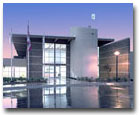A Unique NASA Educational Opportunity
GAVRT
Goldstone
Apple
Valley
Radio
Telescope
- GAVRT teaches students to use radio astronomy, to control a huge antenna, and to collect science data from objects in the universe at which the antenna is pointed.
- GAVRT trains teachers, provides curriculum, and supports classroom implementation.
- GAVRT uses the Internet to connect students to Operations Control and the antenna.
- Students are actively involved in handling data for real science applications and learn that science is an ongoing process.
 Teacher Training:
Teacher Training:
Teachers attend a 5-day training course at the Lewis Center for Educational Research (LCER) in California, or at a
regional training center. There they learn the fundamentals of radio astronomy. Teachers receive guidelines on the use
of the curriculum provided and learn how to operate the 34-meter antenna. In California, they meet the staff at the LCER
Operations Control Center and travel to Goldstone to inspect the antenna up close.
Once they return to their classrooms, teachers receive ongoing support from LCER on questions about curriculum issues
and, of course, when they are on line gathering data.
 What Students Experience:
What Students Experience:
Students remotely control the telescope via the Internet by connecting from their classroom to Operations Control at
LCER, who then pass control of the antenna to the students. Students learn how to gather data, what that data means,
and how to analyze and record it using a computer software program. They work together, learning team participation
and problem-solving skills. The results of the student data analysis are forwarded to the Jet Propulsion Laboratory (JPL) for
inclusion in a database of scientific knowledge.
Curriculum:
The goal is to reach students in K-12 grades. Currently, curriculum is available for students in upper elementary to
high school, with a few lessons for the younger grades. The educators at LCER have written broad-based, multidiscipline
curriculum guides, which teachers can either implement as they are or adapt to fit their own lesson plans.
The GAVRT curriculum can be used as a vehicle for integrated studies in elementary and middle school grades. High school science classes usually concentrate on the more complex science results and lessons featured in the guide. GAVRT is intended to reach children of all backgrounds and educational levels and is not an extracurricular or gifted program.
The GAVRT curriculum meets National Science Education Standards and is adapted to meet individual State Education Standards.
 The curriculum project used most widely is Jupiter Quest, where students plan a hypothetical mission to the Jovian system.
The telescope is used to measure the temperature of Jupiter's atmosphere and study variations in the radio emissions from
Jupiter's intense radiation belts.
The curriculum project used most widely is Jupiter Quest, where students plan a hypothetical mission to the Jovian system.
The telescope is used to measure the temperature of Jupiter's atmosphere and study variations in the radio emissions from
Jupiter's intense radiation belts.
 The Radio Telescope:
The Radio Telescope:
The radio telescope is located at the Goldstone Deep Space Communications Complex in the Mojave Desert, near
Barstow, California. The antenna has a dish 34 meters (110 feet) in diameter, is nine stories high, and weighs 850,000
pounds. Known as Deep Space Station 12 (DSS-12), the antenna was used by NASA's Deep Space Network to track
robotic planetary missions such as the Mariner missions, Voyagers 1 and 2, Galileo, and other spacecraft exploring the
Solar System.
 The Partnership:
The Partnership:
GAVRT is a partnership involving NASA, the
Jet Propulsion Laboratory (JPL), and the
Lewis Center for Educational Research (LCER) in Apple Valley, California, and
more recently, the teachers and students who have joined the GAVRT team from around the United States. Teachers and
students from schools across the U.S. partner with professional science teams as they conduct GAVRT science research
projects.
Mission Statement:
The purpose of the GAVRT project is to provide students and educators with curriculum vehicles that will promote
science literacy, to support a better understanding of the scientific community, and to provide the opportunity to collect
real-time data with sophisticated science equipment through distance learning.
Click here for the GAVRT Fact Sheet (PDF File, 63 kB).
The GAVRT Project is now available for students K-12.
GAVRT 4-minute video:
View a 4-minute video describing the GAVRT project. Middle and high school students collect data via the Internet using a 34-meter radio telescope and teachers express their views as to why GAVRT is successful in their classrooms.
For details of how to sign up to participate in the GAVRT project, check the website at http://www.gavrt.org
Or e-mail kim@avstc.org
Or write:
The Lewis Center for Educational Research
17500 Mana Road
Apple Valley, CA 92307




